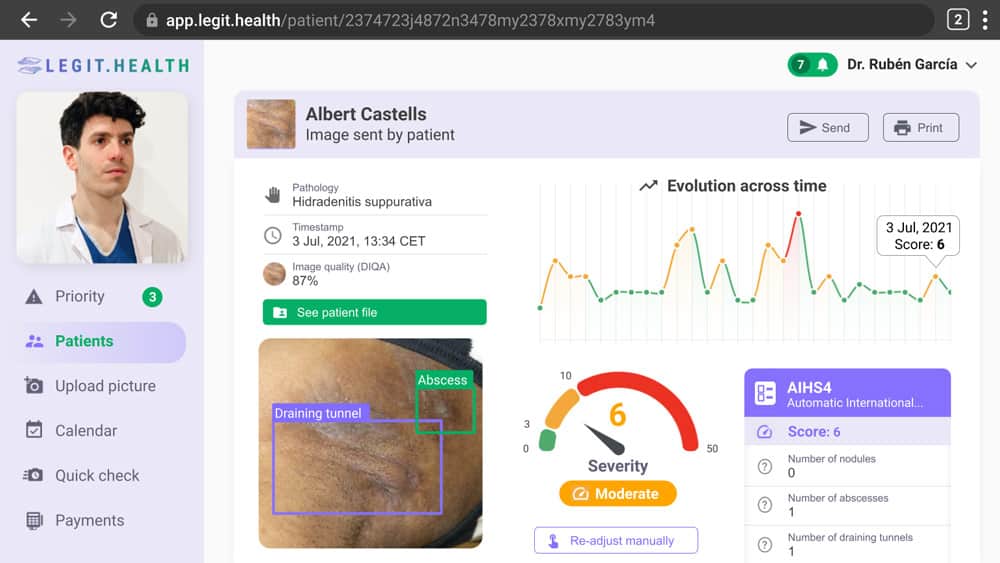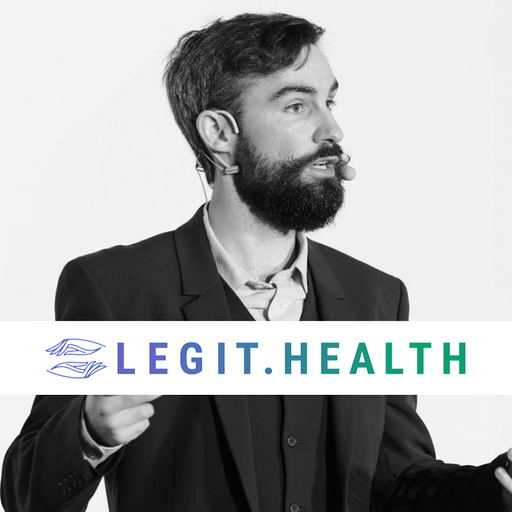AIHS4, A revolutionary step forward in the international hidradenitis suppurativa severity score
Introduction
The future of measuring hidradenitis suppurativa is here thanks to Legit.Health's revolutionary AIHS4 (Automatic, International Hidradenitis Suppurativa Severity Scoring System). The researchers have developed a tool that processes smartphone images and automatically analyses them using the same criteria as the IHS4.
Is widely known that objective, reliable, and precise outcome measures are key to the practice of evidence-based medicine. In the case of hidradenitis suppurativa, the IHS4 is the most modern and reliable measurement tool, widely recommended for its use in clinical trials and daily practice. That's why Legit.Health has chosen it as a basis for its new and revolutionary technology.
The AIHS4 has been echoed in recent scientific publications, such as the following article by the National Research Council of Italy, and the Universities of Palermo and Messina:
(...) to overcome the IHS4, which is time-consuming and subject to variability, the AIHS4 is introduced, using a DL model, Legit.Health-IHS4net, for lesion detection (...). This evidence highlights the utility of AI in evidence-based dermatology, offering a potential tool to empower dermatologists in daily practice and clinical trials.
(...) The Automatic International Hidradenitis Suppurativa Severity Score System (AIHS4), an automatic equivalent of IHS4 that deploys a deep learning model for lesion detection, is a proof of concept with promising results. The algorithm assesses inflammatory nodules, abscesses, and draining tunnels allowing for supervision by physicians.
The origins of IHS4
Before the development of the IHS4 in 2017, other systems such as the Hurley classification or the Modified Sartorius Score were widely used by physicians. Although these older systems lacked granularity and precision, the absence of an alternative method made them widespread in both clinical practice and trials.
However, it [Hurley's classification] is static and was not designed as a dynamic score for accurate assessment of the extent of inflammation within each stage.
The IHS4 was developed with those issues in mind, and the panel of experts that put it together focused on reaching a more objective, precise, and reliable way of measuring the severity of hidradenitis suppurativa.
The formula developed by the panel of experts added the three more common symptoms of Hidradenitis suppurativa and multiplied them by a factor relevant to how indicative they were to the severity of the disease. This way, the number of nodules is multiplied by 1, the number of abscesses by 2, and the number of draining tunnels (fistulae/sinuses) by 4.
All of this added, make the IHS4 score. Said score is then compared against a small reference table that assigns an interpretable meaning to each bracket of scores.
- Less than 4 points: Mild
- Between 4 and 10 points: Moderate
- More than 10 points: Severe
Adapted from "Development and validation of the International Hidradenitis Suppurativa Severity Score System (IHS4), a novel dynamic scoring system to assess HS severity". C.C. Zouboulis, T. Tzellos, A. Kyrgidis et all, on behalf of the European Hidradenitis Suppurativa Foundation Investigator Group.
Limitations of the pen-and-paper IHS4
A precise classification of disease severity is based on the subjective assessment of the clinical manifestation by a physician, so the doctor's experience plays a significant role.
Despite its contributions to solving the issues of its predecessors, the IHS4 presents the same issues as many other scoring systems: a high degree of subjectivity derived from the visual nature of the test and a process reported by many doctors as too time-consuming and tedious.
Do you want to see the clinical AI technology in action?
Stepping over digital calculators
The case of the IHS4 is a very special one. Unlike most dermatological scoring systems for other diseases, such as PASI or SCORAD, the relatively new development of this method has allowed the medical community to skip one common yet outdated step in the advancement of the state of the art for this field.
This step, consisting of developing a computer calculator, tries to tackle one of the main issues with any scoring system: The time needed to apply it properly. They do it by turning the many calculations the doctors usually need to make into an automatic process.
This is yet to happen in the diagnosis of hidradenitis suppurativa, as the IHS4 is a relatively young scoring system and there has not been enough time for one of these calculators to emerge.
Instead of that, with AIHS4, we are jumping right into the future of dermatology by addressing both the issues of time and objectivity within the traditional method.
How do we know if a scoring system is good?
When it comes to dermatological assessments, the effectiveness of a scoring system is paramount. But what exactly makes a scoring system reliable and useful? Through scientific consensus, several key factors have been identified that contribute to the robustness of these systems. Let's delve into these crucial elements:
- Ease of Use: This factor considers whether the system can be applied effortlessly within the constraints of time and financial resources. A user-friendly system is crucial for widespread adoption in clinical settings.
- Sensitivity to Change: An effective scoring system must be capable of detecting clinically meaningful changes over time. This sensitivity ensures that any progress or deterioration in a patient's condition is accurately captured.
- Interobserver Reliability: This refers to the consistency of the results when different observers use the scoring system. High interobserver reliability means different clinicians will arrive at similar conclusions, enhancing the system's credibility.
- Intra-observer Variability: This looks at the consistency of results when the same observer uses the scoring system multiple times. Low intra-observer variability indicates that the system provides stable results, irrespective of repeated assessments by the same clinician.
- Interpretability: A practical scoring system should provide meaningful qualitative interpretations of its scores, like categorizing the severity of a condition as mild, moderate, or severe.
These criteria not only ensure the scoring system's effectiveness but also its applicability and reliability in diverse clinical scenarios.
Adapted from "Methods and definitions to rate the quality of outcome measures". Schmitt, J., Langan, S., Deckert, S., Svensson, A., von Kobyletzki, L., Thomas, K., & Spuls, P. (2013). Assessment of clinical signs of atopic dermatitis: A systematic review and recommendation. Journal of Allergy and Clinical Immunology, 132(6), 1337--1347. doi:10.1016/j.jaci.2013.07.008.
7 ways in which AIHS4 is better
The revolutionary tool developed by Legit.Health allows next-generation dermatologists to practice evidence-based medicine while speeding up the reporting process for the pathology and increasing the patient's autonomy and control.
Publication of the automatic version of the IHS4 in the journal Skin Research and Technology.
This app uses deep learning algorithms to relieve doctors from the tedious manual calculation of scoring systems, by automatically grading lesions by analyzing smartphone images and small patient-reported outcome measures (PROMs). In other words: the tool will automatically fill in most of the dermatology scoring systems, such as PASI, SCORAD, UAS, GAGS, and of course, IHS4.
This means that the new version of this scoring system extracts data precisely and consistently, both during routine evaluations and clinical research. The improvement can be seen in the following table, which compares the performance metrics of the most common way of using scoring systems:
| Pen and Paper | Digital | Automatic (AI) | |
|---|---|---|---|
| Self-supervision | - | - | Perform diagnosis |
| Ease of use | ≈ 600 seconds | ≈ 420 seconds | ≈ 23 seconds |
| Sensitivity to change | 0 to 4 | 0 to 4 | 0 to 100 |
| Interobserver variability | Medium (20%) | Medium (20%) | Lowest (8%) |
| Intra-observer variability | High | High | Zero |
Table 1: comparison between different methods of scoring the severity of a disease. The automatic artificial intelligence-powered method performs better across most performance indicators.
Thanks to the deep learning algorithms, Legit.Health relieves doctors from the tedious manual calculation of scoring systems and allows the practice of a more objective evidence-based dermatology. Also, by using algorithms to measure dryness, lichenification, erythema, oozing, oedema, and many more signs, the tool can calculate visual signs in a more reliably and consistently.
1. AIHS4 improves the rate of correct diagnosis
The algorithm created by Legit.Health isn't limited to measuring the severity of the affection as the IHS4 does, it also has been trained using the input of top dermatologists to be able to distinguish between hundreds of conditions, including most abscess-producing diseases.
This telematic follow-up prevented school absences in paediatric patients, work absences in adults, and allowed the follow-up of patients in quarantine due to COVID-19 or with diseases that make it difficult to travel. Both patients and their dermatologists showed a high degree of satisfaction with the use of the app, with 100% of patients interested in continuing to use the tool.
Thus, AIHS4 will assist the doctor in the disease assessment process, not only by making it quicker by providing relevant information but improving the rate of correct diagnosis by 23% in the case of primary care physicians.
Do you want to see the clinical AI technology in action?
2. Easier to use and faster than its analogic counterpart
One of the main advantages of the AIHS4 over the traditional methods is its speed. Where an experienced doctor might need six or seven minutes to completely fill in and calculate the IHS4, Legit.Health's algorithm only needs 23 seconds to get the final score.
The disease severity assessment is often confusing, especially for young, inexperienced dermatologists.
This entails an incredible advantage for its users, both from a time management and clinical perspective. The harsh reality is that many physicians won't take the time to properly fill in any scoring system at all, and will rely on a gut estimate to determine the severity of the affection. This happens because traditional scoring systems are widely considered too tedious and time-consuming for a practical application on a day-to-day basis.
Thanks to AIHS4 that should no longer be a concern. This fast and easy-to-use tool puts its usability at the forefront of its design and strives to facilitate the practice of evidence-based medicine.
3. AIHS4 can detect small changes in the evolution of the pathology
Legit.Health's tool analyzes the pathologies using a validated scoring system that has both the lowest MID (Minimal important Difference) and is sensible to the lowest LDC (Lowest Detectable Change), which means the algorithm analyzes every image with more precision and attention to detail than any human observer would.
Furthermore, it has a higher validity and reliability while maintaining comparable clinimetric properties, thanks to the intrinsic functioning of computer vision algorithms.
Given the complexity of determining the severity of a disease like hidradenitis suppurativa, the AIHS4 provides the kind of granularity and precision needed to provide the doctor with all the information needed for a successful diagnosis.
4. Provides a reduction in inter-observer variability
The experimental results show that AIHS4 outperforms significantly the baseline methods when it comes to inter-observer variability, as the algorithm achieves a mean absolute percentage of error of just 8%, way lower than the usual 20% that is observed in the classical application of the IHS4.
Estimating is guessing, counting is measuring
Additionally, the reliability of this method will only increase as time passes and the technology gets better, making it possible for the automatic assessment of severity using algorithms to become even more precise in the future.
Do you want to see the clinical AI technology in action?
5. AIHS4 reduces the intra-observer variability to zero
Due to its algorithmic nature, AIHS4 completely eliminates intra-observer variability, as the neural network is perfectly stable in its parameters. In other words, the application has a perfect memory of each image and each diagnosis it has been trained on, and therefore its results are completely realiable over time.
Legit.Health allows the doctor to not rely on his memory when assessing the severity of the affection and focusing on the analysis of the objective data stored in the app reduces considerably the risk of misremembering, providing a more objective, accurate, and precise way of tracing the development of the disease.
This becomes especially important in clinical trials, where reducing this kind of variability is key to gathering the precise data required in this kind of study.
6. The data is more accessible and easier to read
Legit.Health's interface provides access to all the relevant information about the patient in an easy-to-read manner.
Every data derived from the AIHS4 is clearly displayed on the screen, showing the severity of the affection and the different factors considered by the algorithm when analyzing the image and their punctuations.
On the other hand, easy-to-lose paper trails are a thing of the past, especially when you can have all the patient's information, test results, and pictures in a digital database that is constantly backed up.
Automatic IHS4 and for Hidradenitis Suppurativa with Legit.Health
7. An easy way of following the progress of a treatment
As hidradenitis suppurativa is a chronic disease, the post-diagnosis follow-up is crucial for the good development of the treatment.
Legit.Health improves the communication channels between doctor and patient, allowing them to become a more active part of their treatment. The app achieves this by giving the user an easy and reliable way of sending accurate data to the doctor.
Additionally, the app displays the data in an easy-to-read graph showing the progress of the affection, making answering the usually difficult question "Am I getting better, Doctor?" a piece of cake.
Do you want to see the clinical AI technology in action?
Enhancing Evidence-Based Medicine
In the practice of evidence-based medicine, objective, reliable, and precise outcome measures are crucial. Traditionally, HS severity assessment has been subjective, relying on clinical judgment alone. However, the AIHS4 developed by Legit.Health introduces a transformative shift by providing an automated and standardized approach to HS severity scoring.
By utilizing the same criteria as the IHS4, which is highly regarded and recommended for use in clinical trials, Legit.Health ensures that practitioners have access to a modern and reliable measurement tool. This advancement empowers healthcare professionals to make informed decisions, track disease progression accurately, and evaluate treatment efficacy with greater confidence.
Implementation of Value-Based Healthcare
Value-based healthcare aims to optimize patient outcomes while maximizing the value of healthcare resources. By offering an automated HS severity scoring system, Legit.Health supports the implementation of value-based healthcare in the management of HS. Here's how:
- Standardization and Consistency: The AIHS4 ensures standardized and consistent assessment across various healthcare settings. By removing subjective variability, practitioners can establish a unified language for HS severity, facilitating effective communication, and improving treatment planning.
- Efficiency and Time Savings: The automated analysis of smartphone images significantly reduces the time and effort required for HS severity assessment. This streamlined process allows practitioners to focus on delivering timely interventions, enhancing patient care, and optimizing resource allocation.
- Enhanced Patient-Centered Care: By providing accurate and objective HS severity scores, Legit.Health's AIHS4 contributes to patient-centered care. Clear documentation of disease progression helps clinicians involve patients in shared decision-making, tailor treatment plans, and set realistic goals, ultimately improving patient satisfaction and outcomes.
- Real-World Data and Research: The AIHS4 tool generates a wealth of standardized data that can be used for research and clinical studies. This data repository enables further understanding of HS, identification of novel treatment approaches, and evaluation of interventions, fostering continuous improvement and innovation in HS management.
Do you want to see the clinical AI technology in action?
Legit.Health's Automatic, International Hidradenitis Suppurativa Severity Scoring System (AIHS4) represents a major breakthrough in the field of HS. By harnessing the power of AI and adhering to the established IHS4 criteria, this innovative technology provides practitioners with a reliable, efficient, and objective method for assessing HS severity. The implementation of AIHS4 not only enhances evidence-based medicine but also enables the implementation of value-based healthcare, benefiting both healthcare providers and HS patients alike. With Legit.Health's pioneering contribution, the future of HS care looks brighter than ever before.
In conclusion
We cannot improve what we cannot measure, and thanks to AIHS4 and Legit.Health the future of the study and treatment of hidradenitis suppurativa is brighter than ever.
Is not hard to see how a technology that helps doctors to better manage their time and to collect data more reliably and consistently is the future of the medical field.
Thanks to Legit.Health, doctors across the globe can improve their correct diagnosis rate by 23% and make treatment easier to follow for the patient by turning them into active participants in their own recovery while enabling the doctor to practice evidence-based medicine.
Work with us
At Legit.Health, we are working to further improve the technology of AIHS4, striving to create even better tools. This includes, for example, improving the differentiation between types of HS lesions, or ensuring that the technology works correctly across all skin phototypes.
If you would like to work with us, please fill out the following form and we will contact you as soon as possible.



